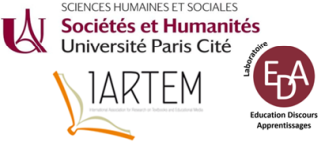Publication of poor reading results in international reading assessments such as PISA 2022 and PIRLS 2021 has once again brought attention to students' (lack of) reading competencies. Particularly noteworthy in this context is the finding that Danish students read fictional texts better than informative ones, and their reading proficiency in informative texts has significantly declined since 2016 (Fougt et al., 2023, p. 14). The informative texts are characterized by a high degree of multimodality.
Both analog and digital learning materials employ various representational forms. The purpose of this can be to create a motivating layout and to enhance the readability of texts for students (generic academic reading). However, these different representational forms are also used to communicate academically (disciplinary literacy). In school education, students must acquire the language and modes of thinking specific to each subject, and consequently, learn to read and understand the multimodal representations of academic texts in a subject-specific manner. However, research on multimodal subject-specific reading is currently underexplored.
The present project investigates:
How is multimodality used in a subject-specific manner in didactic learning materials for intermediate-level students in the subjects of Danish (L1), history, and religious studies?
Teaching in these three subjects in Denmark is characterized by students independently ‘reading for learning'.
The project is part of a larger initiative that also examines how students read and utilize multimodal constructions in existing learning materials (including eye-tracking studies) and explores how new learning designs can support students' effective use of multimodal constructions, thereby increasing their learning outcomes. The overall project consists of two main phases: a descriptive phase, examining existing learning materials and students' current reading practices, and an intervention phase, investigating the outcomes of altered learning designs.
The subproject presented here examines three didactic learning materials for each of the three subjects through a qualitative document study with a descriptive aim. The unique possibilities for multimodal integration in digital learning materials, combined with the increasing use of digital materials in Danish primary schools, make them a relevant subject to explore. The materials were selected as they are geared towards the intermediate level and are part of a collection of ‘widely used' units on a digital subject portal. Publisher-produced digital portals with didactic units covering the entire school curriculum are frequently utilized in the Danish primary school system. These portals are characterized by a consistent expression at the portal level across subjects and grades. By choosing to analyze units from different subjects but on the same subject portal, there is an opportunity to focus on the subject-specific use of multimodal constructions rather than the educational material producer's use of multimodal learning design. This allows for a distinction between generic ways of utilizing multimodality (at the portal level) and subject-specific ways of using multimodal constructions (at the unit level).
Theoretical grounding for the study is multimodality theory from a social semiotic perspective (Kress & van Leeuwen, 2021) and disciplinary literacy theory (Shanahan & Shanahan, 2012). Disciplinary literacy theory addresses how subject-specific goals are achieved through a subject-specific approach to reading, but the theory has thus far primarily focused on the reading of verbal-linguistic representational forms.
Learning material analyses are conducted with a specific focus on examining the multimodal constructions present in the units and what characterizes and potentially differentiates them within and between the three subjects. The multimodal constructions are characterized by various representational forms, such as visual, diagrammatic, or linguistic (Hansen, 2018). Additionally, the relationships between the elements of the multimodal constructions (van Leeuwen, 2005) are explored, and finally, how these multimodal constructions contribute to realizing the content, goals, and characteristics of each subject.
Results from the investigation of learning materials for intermediate-level Danish (L1), history, and religious studies will be presented and discussed at the conference.
References:
Fougt, S. S., Neubert, K., Kristensen, R. M., Gabrielsson, R. H., Molbæk, L., & Kjeldsen, C. C. (2023). Danske elevers læsekompetence i 4. klasse: Resultater af PIRLS-undersøgelsen 2021. Aarhus University Press. https://doi.org/10.2307/jj.3850481 [Danish Fourth-Grade Students' Reading Competence: Results of the PIRLS 2021 Study]
Hansen, T. I. (2018). Multimodalitet som didaktisk kategori. Learning Tech, 4(5), 60–85. https://doi.org/10.7146/lt.v4i5.111565 [Multimodality as a Didactic Category]
Kress, G. & Van Leeuwen, T. (2021). Reading Images. The Grammar of Visual Design, Third edition. Routledge
Shanahan, T., & Shanahan, C. (2012). What is disciplinary literacy and why does it matter? Topics in Language Disorders, 32(1), 7–18.
Van Leeuwen, T. (2005). Introducing Social Semiotics. Routledge

 PDF version
PDF version
